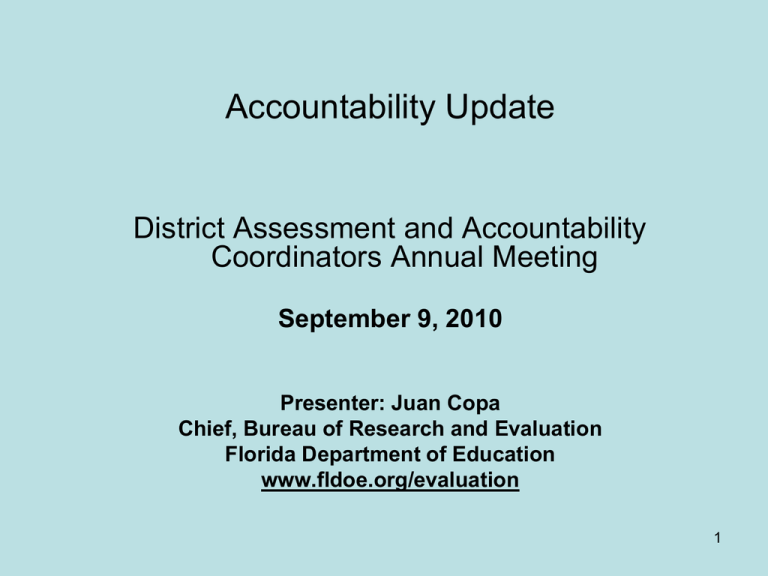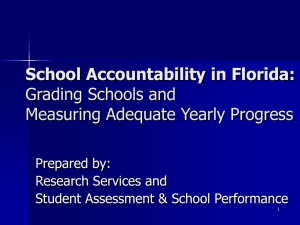2010 Accountability Update, Annual District Coordinators' Meeting
advertisement

Accountability Update District Assessment and Accountability Coordinators Annual Meeting September 9, 2010 Presenter: Juan Copa Chief, Bureau of Research and Evaluation Florida Department of Education www.fldoe.org/evaluation 1 Topics Accountability Systems, Current Status: • • • School Grading (FCAT-Based Measures) - Recap of 2009-10 Changes Adequate Yearly Progress (AYP), 2009-10 - Reporting Ethnicity and Race under New Federal Classifications High School Grades, 2009-10 Accountability Update – Beyond 2009-10: • Transitioning from FCAT Math to EOC Tests in HS Systems (School Grades and AYP) 2 Overview of School Grades and Adequate Yearly Progress, 2009-10 3 School Grades Overview – FCAT half of the Formula P O I N T S C O M P O N E N T S READING MATH WRITING SCIENCE Performance Performance Performance Performance Learning Gains Learning Gains of Lowest 25% A = ≥ 525 B = 495 - 524 C = 435 - 494 D = 395 - 434 F = < 395 Learning Gains Learning Gains of Lowest 25% Bonus Points for Retakes (11th & 12th grade) Points: 400 for Performance 400 for Learning Gains 800 = Possible Points (100 for each of 8 components) Possible Bonus Pts. = 10 Additional requirements applied AFTER a school’s points are calculated: • Adequate Progress for Lowest 25%—required to earn grade based on calculated points. If a school does not meet this requirement, the school’s grade is lowered one letter grade. • Participation Requirement (Percent Tested)—required to earn grade based on calculated points. Schools must test at least 95% of their students to earn an “A”, at least 90% to earn any other grade. 4 Recap of Changes to School Grades in 2009-10 • Florida Alternate Assessment (FAA) results for students with disabilities are now included in the overall learning gains components for reading and math. (This will only apply to students who took the FAA but not the FCAT.) – A learning gain for the FAA is defined as any positive movement in achievement levels (1 to 9); or the maintenance of a proficient level (4 or higher). • The minimum cell size for the writing and science performance measures has been re-set at 10. Schools that have enough students tested in reading and math to receive a grade but that do not have at least 10 eligible students tested in writing and/or science will receive the district average for those measures. • The school’s percent-proficient figure for writing was based on the average of the percent scoring at 3 and above and the percent scoring at 4 and above. 5 *Pre-appeals for 2010. 6 *Pre-appeals for 2010. 7 More Information on School Grades For a more detailed description of the School Grades Calculation and Processes, please refer to the School Grades Technical Assistance paper. The School Grades TAP can be accessed on our website at: http://schoolgrades.fldoe.org/pdf/0910/2010SchoolGradesTAP.pdf 8 AYP Overview Writing Criteria Met? 90% score a 3.0 or higher, or the school improves by at least 1% over the prior year (YES/NO) Graduation Criteria Met? 85% graduate (NCLB methodology) or the school improves by at least 2% over the prior year (YES/NO) School Grade Not D or F? YES/NO Reading 95% Tested? Math 95% Tested? Reading Proficiency Target Met? Math Proficiency Target Met? Total YES/NO YES/NO YES/NO YES/NO White YES/NO YES/NO YES/NO YES/NO Black YES/NO YES/NO YES/NO YES/NO Hispanic YES/NO YES/NO YES/NO YES/NO Asian YES/NO YES/NO YES/NO YES/NO American Indian YES/NO YES/NO YES/NO YES/NO Economically Disadvantaged YES/NO YES/NO YES/NO YES/NO English Language Learners YES/NO YES/NO YES/NO YES/NO Students with Disabilities YES/NO YES/NO YES/NO YES/NO 9 Annual Proficiency Targets (AYP Percent-Proficient Targets) Reading Target Mathematics Target 2001-02 31% 38% 2002-03 31% 38% 2003-04 31% 38% 2004-05 37% 44% 2005-06 44% 50% 2006-07 51% 56% 2007-08 58% 62% 2008-09 65% 68% 2009-10 72% 74% 2010-11 79% 80% 2011-12 86% 86% 2012-13 93% 93% 2013-14 100% 100% 10 No Child Left Behind Adequate Yearly Progress Florida Schools Making AYP *Pre-appeals for 2010 80% 70% 60% 50% 40% 30% 20% 10% 0% 36% 29% 23% 34% 24% 23% 13% 2004 AYP 2005 2006 2007 2008 2009 2010 2009-10 2008-09 2007-08 2006-07 2005-06 2004-05 2003-04 456 785 792 1,088 916 1,117 719 No 2,967 2,645 2,514 2,156 2,282 1,989 2,349 Total Y & N 3,423 3,430 3,306 3,244 3,198 3,106 3,068 Yes 11 Recap of Changes to AYP in 2009-10 • • Proficiency targets for reading and mathematics increased to 72% and 74%, respectively, as Florida continues to move toward the federally mandated goal of 100% proficiency by 2013-14. Beginning in 2009-10, in order for a school to meet the graduation rate criteria for AYP, a school must attain a graduation rate of 85% or higher (no change from earlier years), or show an improvement of at least 2% over the prior year (change from the earlier annual target of 1% improvement). – This change was the result of a required US Department of Education peer review of each state’s graduation rate, goal, and targets that occurred earlier this year under 34 CFR s. 200.19(b)(6)(ii) • Beginning in 2009-10, school districts began reporting the new federal classifications for ethnicity and race (in addition to the old reporting method). 12 AYP Subgroups, 2009-10 American Indian* Asian* Black (African American)* Hispanic* White* Economically Disadvantaged English Language Learners Students with Disabilities Total (All Students) * Current racial/ethnic group reporting categories. 13 Reporting Race/Ethnicity for AYP • The new federal ethnicity reporting criteria will not be applied to AYP until the 2010-11 school year. Further, we expect no changes to the current racial/ethnic subgroups that we currently are reporting for AYP. • Under the new reporting criteria, every student’s demographic record will include a data element for “Ethnicity” that addresses whether or not the student is Hispanic, plus five separate data elements for “Race,” with each reported as a Y/N at the student level. • All students with a “Y” reported for “Ethnicity” will be classified as Hispanic for AYP reporting when the requirements become applicable (2010-11). 14 Reporting Race/Ethnicity for AYP • • • Though districts will report a separate “Race” classification for Hispanic students (“Ethnicity”), Hispanic students will not be included in other racial subgroups. – They will continue to be included in the All Students group, and could potentially be included in the Economically Disadvantaged, English Language Learner, or Students with Disabilities subgroups (as currently). For student aggregate data, the classification of “two or more” race subgroups is attributed to each student for whom more than one race element is reported as “Y.” These students are currently classified as “multiracial” and are not reported under a separate racial/ethnic category for AYP. They will not be reported as a separate category going forward, either. States will be able to continue to use their current classifications for reporting on racial/ethnic groups for AYP, per guidance from the Forum Guide to Implementing New Federal Race and Ethnicity Categories, p.41 (http://nces.ed.gov/pubs2008/2008802.pdf). 15 More Information on AYP For a more detailed description of the Adequate Yearly Progress (AYP) calculation and processes, please refer to the AYP Technical Assistance paper. The AYP TAP can be accessed on our website at: http://schoolgrades.fldoe.org/pdf/0910/2010AYPTAP.pdf A technical assistance paper on the new reporting criteria for ethnicity and race is available at http://www.fldoe.org/eias/dataweb/tech/race.pdf 16 Still to Come: High School Grades, 2009-10 17 Review of High School Grades • Senate Bill 1908 (2008 Legislative Session) requires a significant change to the way high schools are graded beginning with the 2009-10 School Year. • In addition to the vital foundation of assessment results in Grades 9, 10, and 11 (Science), the law requires an equal focus be placed on: – Access to rigorous, accelerated coursework, as well as performance in rigorous, accelerated coursework. – College Readiness – Graduation rates for all students as well as those academically at-risk. • A full description of the High School Grades Model can be found on our website at: http://schoolgrades.fldoe.org/ppt/HSAccountability.ppt High School Grade Components - Overview GRADUATION ACCELERATION READINESS GROWTH/DECLINE Overall Rate 200 Participation 200 (in 2009-10) 175 (in 2010-11) 150 (in 2011-12) Performance on Reading 100 For each component schools may earn up to 20 additional points for GROWTH (40 points for factors worth 200 points) At-Risk Rate 100 Performance 100 (in 2009-10) 125 (in 2010-11) 150 (in 2011-12) Performance on Math 100 For each component schools may lose 5 additional points for DECLINE (10 points for factors worth 200 points) Total Graduation Points 300 Total Acceleration Points 300 Total Readiness Points 200 Total NEW HIGH SCHOOL Points Possible 800 All components are percentages. Those components weighted twice as much as others reflect a calculated percentage that is doubled (e.g., School X has a 75% graduation rate – School X earns 150 points (75*2) for that component). All component values are capped at their maximum values. That is, if a school earns points in excess of the total for a particular component – through the growth adjustment or the escalating weights in the acceleration components – the school will receive the maximum points for that component. 19 • • • • • High School Grades: FAQs and Review Graduation Rate – Which method? Who’s a graduate? Who’s not? How is credit in the formula for accelerated coursework determined? What are the “readiness for college” cut scores? How are grades for combination schools determined? Sources of data? Graduation Rate – Method and Who Counts as a Graduate and a Non-Graduate Graduation Rate Methods Students Not Included in the Calculation Graduates Non-Graduates For use in 2009-10 and 2010-11 Students who transfer to: • Other schools (public, private, or Dept. of Juvenile Justice facilities); • Home-education programs; • Adult education programs Deceased students • Standard Diploma recipients • Special Diploma recipients • • • • Students who transfer to: • Other schools (public or private) • Home-education programs Deceased students • Standard Diploma recipients • • • • National Governors Association (NGA) Rate For use beginning in 201112 New Federal Uniform Rate *Note: If federal requirements for the uniform rate change in the interim, Florida’s federal uniform rate calculation will be adjusted accordingly. Dropouts Certificate of Completion recipients GED recipients Continuing enrollees who are not ontime graduates Dropouts Certificate of Completion recipients GED recipients Continuing enrollees who are not ontime graduates • Special Diplomas • Transfers to Adult education programs or Dept. of Juvenile Justice facilities who are not standard diploma recipients. 21 Performance in Accelerated Coursework Key Documents: For AP, IB, and AICE: • Articulation Coordinating Committee’s Credit by Exam Equivalencies – http://www.fldoe.org/articulation/pdf/ACC-CBE.pdf For Industry Certification: • Industry Certification Funding List: – http://www.fldoe.org/workforce/fcpea/default.asp • Career and Technical Education Statewide Articulation Agreements: Industry Certification to AAS/AS Degrees – http://www.fldoe.org/workforce/dwdframe/artic_indcert2aas.asp 22 Performance in Accelerated Coursework Successful Outcomes are defined as: AP Score of 3 1 Successful Outcome Score of 4 or 5 1 or 2 Successful Outcomes (depending on ACC Credit-by-Exam Equivalencies) IB Score of 4 1 Successful Outcome Score of 5, 6, or 7 1 or 2 Successful Outcomes (depending on ACC Credit-by-Exam Equivalencies) AICE Passing Score on an AS Level AICE Exam 1 Successful Outcome Passing Score on an A Level AICE Exam 1 or 2 Successful Outcomes (depending on ACC Credit-by-Exam Equivalencies) Dual Enrollment Passing grade of “C” or higher in the course 1 Successful Outcome Industry Certification Earning an industry certification by exam 1 or multiple successful outcomes based on statewide articulation agreements (http://www.fldoe.org/workforce/dwdframe/artic_frame.asp) 23 Performance in Accelerated Coursework Example: AP: • Student earns a “4” on the AP English Literature and Composition Exam. • According to the Credit by Exam Equivalencies document, a score of “4” on that exam entitles a student to credit (in a Florida public postsecondary institution) in two courses (ENC X101 and ENC X102 or LIT X005) (see page 4 of the Credit by Exam Equivalencies document). • Therefore, that student would earn 2 successful completions for her score of “4”, and be weighted as 1.1 in the numerator of the calculation. 24 Performance in Accelerated Coursework Example: Industry Certification: • Student passes the MSSC Certified Production Technician exam, earning a certification in that area (MSSCN001). • There is a statewide articulation agreement between an industry certification in “MSSC Certified Production Technician” and an AAS/AS program in “Electronics Engineering Technology” awarding a student a minimum 6 credit hours toward that degree. • Therefore, that student would earn 2 successful completions for this certification (6 credits translates into 2 courses), and be weighted as 1.1 in the numerator of the calculation. 25 Postsecondary Readiness Cut Scores http://www.fldoe.org/articulation/perfCPT/default.asp SAT • Verbal: 440 • Math: 440 ACT • Reading: 18 • Math: 19 CPT • Reading: 83 • Elementary Algebra (Math): 72 26 Combination Schools • Combination schools that serve high school grades receive a grade that re-weights the FCAT measures and the new high school measures: – Grade K-12 schools are weighted 80% on the FCAT measures, and 20% on the non-FCAT measures (vs. 50/50 for regular high schools). – Grade 6-12 schools are weighted 70% on the FCAT measures, and 30% on the non-FCAT measures. EXAMPLE • Combination School X accumulates 625 points on the FCATbased measures and 480 points on the new measures. It serves grades K-12. – – – – – Weighting = 80 on FCAT/20 on New Measures 625 x .80 = 500 480 x .20 = 96 To calculate on 800-pt. scale: 596 points = Grade “A” For 1600-pt. scale: 596 x 2 = 1192 = Grade “A” 27 Data Sources for HS Grading Base “Membership” Files used for the new components: INDV File • Acceleration Participation • Acceleration Performance High School Graduation Cohort File • Graduation Rate • At-Risk Graduation Rate • Postsecondary Readiness 28 Data Sources for HS Grading Accelerated Curriculum (Participation and Performance): Vendor Data • AP data: supplied by the College Board, compiled by the Florida Department of Education’s PK-20 Education Data Warehouse (EDW) URL: http://edwapp.doe.state.fl.us/doe/. See also www.collegeboard.com. • IB data: supplied by IBO, compiled by EDW. See also www.ibo.org. Survey 5 Data • AICE data: reported by Florida school districts on the Student Assessment record format, Survey 5. • Dual enrollment data: reported by Florida school districts on the Student Course Transcript Information record format, Survey 5. • Industry certification data: reported by Florida school districts on the Vocational Student Course Schedule record format, Survey 5. • Links to the record format descriptions for reporting AICE, dual enrollment, and industry certification data are accessible online at the following URL: www.fldoe.org/eias/dataweb/student_0910.asp#REPORTING%20FORMATS 29 Data Sources for HS Grading Postsecondary Readiness: Multiple Sources • SAT data: supplied by the College Board, compiled by EDW. See also www.collegeboard.com. • ACT data: supplied by ACT Education, compiled by EDW. See also www.act.org. • CPT data: reported to DOE by colleges and universities, compiled by EDW; augmented by Bright Futures HS transcript data. See also http://www.fldoe.org/articulation/perfCPT/default.asp. • In addition, for postsecondary readiness, the Department will be using high school transcript data to supplement matches with the vendor data (e.g., College Board, ACT). The data on the transcript is reported to determine Bright Futures eligibility. 30 Data Sources for HS Grading Graduation Rate (and At-Risk Graduation Rate): • Processes managed by Education Information and Accountability Services, including provisions for cohort data review. • Source data is all derived from data reporting formats and elements on the DOE student database. • Formats and data elements, as well as programming steps, are presented in the technical guide at http://www.fldoe.org/eias/eiaspubs/word/gradgde0809.rtf . • EIAS contact information: askeias@fldoe.org (850) 245-0400 www.fldoe.org/eias 31 TENTATIVE Target Dates: High School Grades • Tentative Release: Late November/Early December • Data pulled from Survey 5 for accountability purposes: October 22 • Data Review Periods: Late September – November Transition to FCAT 2.0, End-of-Course Assessments, and School Accountability 2010-11 and Beyond 33 School Accountability in the Transition Year, 2010-11 – Current Thinking 2010-11 School Grades • FCAT Grade 9 Math discontinued in 2010-11; FCAT Grade 10 Math continued. • Algebra I EOC implemented (but without achievement levels). • For current-year proficiency, only results for Grade 10 FCAT Math will be used. • For learning gains in math, Grade 9 FCAT scores from 2009-10 will be compared with Grade 10 FCAT scores from 2010-11. No grade 8 to grade 9 FCAT math learning gains data. 2010-11 AYP • FCAT Grade 10 Math will be sole component for AYP proficiency measure at HS level. 34 School Accountability in 2011-12 and Beyond – Current Thinking 2011-12 School Grades • Algebra I EOC replaces FCAT Grade 10 for math proficiency measure (Geometry and Biology EOCs would follow in subsequent years). 2011-12 AYP • Algebra I EOC will be sole component for AYP proficiency measure in math (Proposed to U.S. Dept. of Education). For both School Grades and AYP Use the concept of “banking” to award high school credit for the performance of students who successfully complete high school requirements before entering high school. 35 Big Transition Issues for School Accountability • Maintain the continuity of the accountability system during the transitional year to FCAT 2.0 • Measuring learning gains on FCAT 2.0 and End-of-Course assessments in a rigorous, accurate, and reasonable manner • Ensuring the alignment of standards and expectations for FCAT 2.0 across grade levels 36 Structure to Address These Issues • Leadership Policy Advisory Committee for Assessment and Accountability – Scheduled to meet on September 29 LPAC’s purpose is to advise the Commissioner on strengthening the quality and rigor of Florida’s assessment and accountability system. The goal is to provide recommendations on policies to the Commissioner, working with Florida’s Technical Advisory Committee and the Assessment and Accountability Advisory Committee (Scheduled to meet on October 13) on short- and long-term issues. 37 Other Issues • Writing Criterion for School Grades in 2010-11 – SB 4 requires that a score actually earned by the student (on the 1-6 scale) be used as the criterion for school grades. – Likely move to the standard of 4.0 and above – Topic for the committees • SB 4 changed the deadline for School Recognition decisions from November 1 to February 1. – Change accommodates the later release of high school grades. • Testing of current ninth graders who have completed their Algebra I requirement on the EOC – In discussion with the US DOE on a possible waiver – Inclusion in AYP calculations would not occur until 2011-12. 38 Contact Information E-mail EVALNRPT@fldoe.org Phone (850) 245-0411 Web: www.fldoe.org/evaluation Evaluation and Reporting Section Bureau of Research and Evaluation Florida Department of Education 325 W. Gaines St., Room 1401 Tallahassee, FL 32399 39






